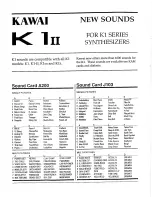
ARTURIA – Matrix-12 V – USER MANUAL
8
It was then Tom Oberheim first made a name for himself through his version of an
electronic device called a ring modulator. These somewhat simple circuits had
been used in radio receivers for a long time, but when applied to a signal in the
audio range the results were often other-worldly.
Case in point: if you have watched enough of the popular BBC show Doctor Who,
you probably know about his nemeses, the Daleks. Their ominous, alien drill-
sergeant voices owe much to the ring modulator (“Exterminate! Exterminate!”).
And many of the bell-like tones you’ve heard from analog synths through the years
also came from ring modulators. So these devices are still in use!
Initially Tom made a couple of these for some musician friends, one of whom was
in a psychedelic band called The United States of America. Word got around, one
thing led to another, and the next thing he knew he was being contacted by the
Chicago Musical Instruments Company (CMI).
CMI wanted Tom to develop a ring modulator, which he did (the Maestro RM-1A).
Good for them, and even better for us: this odd little box led directly to the
formation of Oberheim Electronics.
The Maestro RM-1A, circa 1969
The RM-1A was followed by the Maestro PS-1, a phase shifter which also became
very popular. And for the next five years or so a steady stream of interesting and
useful products were designed for CMI by Tom Oberheim.
1.1.3
Technological innovations
Our main focus in these sections will be the synthesizer products Mr. Oberheim
brought to life. However, some of his other contributions to the music world are
noteworthy:
1.1.3.1
Polyphony
Sometimes it’s good to be reminded: Back in the “old days” it wasn’t possible to
play a chord on a synthesizer keyboard. You could only play one note at a time.









































